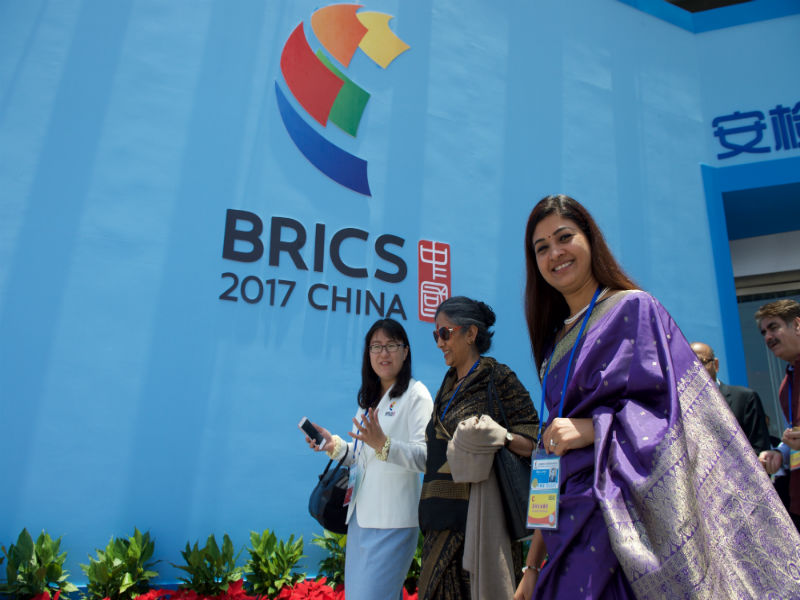[BRICS-Xiamen]BRICS Collaboration and China-India Cooperation

China is now leading the BRICS mechanism into a second “golden decade” as the country assumes the rotating chair of the influential group in 2017. Over the past 10 years, BRICS mechanism has ushered in a new era of unity and cooperation between emerging markets and developing countries, and left a brilliant record of BRICS countries working together to accelerate global economic growth, improving global governance and promoting democracy in international relations.

The BRICS mechanism conforms to the trend of multi-polarity and economic globalization, and represents the consensus of its five members, which all seek cooperation and development. Chinese President Xi Jinping once likened the BRICS countries to five fingers—each having distinctive features and strengths, but form a powerful fist when clenched together. Guided by the principle of development through cooperation, BRICS countries have become increasingly stronger over the past decade. Their combined GDP has increased from 12 percent to 23 percent of the world’s total, trade volume from 11 percent to 16 percent, and outbound investments from 7 percent to 12 percent. BRICS members collectively contribute to more than 50 percent of global economic growth. Moreover, BRICS countries continue expanding scopes of cooperation, from economic and trade cooperation to three pillars of cooperation—political security, economy and finance and people-to-people exchanges, making the group a significant player on the world stage.
Cooperation and development complement each other. This is the most important lesson drawn by BRICS countries in the past decade of evolvement of the BRICS mechanism. The world today has reached a new historical stage. The world economy has already begun to rebound, but in-depth contradictions remain unsettled, causing considerable uncertainty. International coordination remains a daunting task. Global challenges in areas like development, refugees, climate change and anti-terrorism are becoming more complex alongside the rise of nationalism, extremism, anti-globalization and trade protectionism. How BRICS countries tackle new challenges has evoked wide attention from the international community. As President Xi once said, true partnership is not just about celebrating success together—it is more about standing together in times of adversity. Undoubtedly, BRICS countries need to continue to seek answers from collaborative development. At the beginning of this year, President Xi sent letters to leaders of other BRICS countries, putting forward China’s ideas for the Xiamen Summit, including deepening practical cooperation for common development, strengthening global governance to jointly address challenges, carrying out people-to-people and cultural exchanges to consolidate popular support, and promoting institution building to forge more extensive partnerships. This roadmap for the deepened cooperation between BRICS countries is concise and clear.
BRICS countries have distinctive features in their development, and can complement each other, creating huge space for cooperation. For instance, China boasts a complete industrial system, advantageous manufacturing products, rich experience in infrastructure construction and a strong financial capacity. Dubbed the world’s “back office,” India has developed an IT industry with competitive edge and a financial industry with unique feature while experiencing rapid infrastructure development. If united, BRICS countries will surely give impetus to deepening BRICS cooperation, provide new solutions on global governance, make new contributions to global economic growth, and create a brighter future for themselves and the world.
China-India cooperation not only reflects the requirements for the two countries as key BRICS members, but is logical choice for their development. The two countries share similar development ideas and strategies and can complement each other with their respective advantages. They have more common interests than differences, and greater need for cooperation than competition. In recent years, relations between the two countries have maintained a momentum of development on the whole and cooperation in sectors including politics, economics, trade, culture, people-to-people and local exchanges, law enforcement and security has been substantially strengthened. China and India have particularly engaged in close cooperation in economic and trade sectors. So far, cumulative investment of Chinese enterprises in India has reached nearly US$5 billion and is still rising. More than 500 Chinese companies have settled in India. Besides early “trailblazers” like Huawei and ZTE, many other famous Chinese enterprises such as China Fortune Land Development Co., Ltd. have also invested in India to build industrial parks and other projects. Latecomers such as OPPO, VIVO, Xiaomi and Lenovo expanded even faster in the Indian market. In 2016, bilateral trade volume between China and India reached US$71.18 billion. In the first five months of this year, China-India trade volume stood at US$33.29 billion, an increase of 22.6 percent year-on-year. India’s exports to China increased by 46.4 percent. Sectors such as railways, telecommunication equipment, clean energy, engineering equipment and industrial parks are becoming new platforms for China and India to deepen and expand cooperation. Furthermore, Indian enterprises engaged in information technology, pharmaceuticals and consulting services have entered the Chinese market and performed impressively.
China and India are important neighbors. In recent years, their bilateral ties have generally maintained sound development. Stable China-India relations will not only serve the fundamental interests of the two countries and their people, but also be conducive to regional and global peace, stability and development.
As China-India relations have great potential to grow, the two countries should work together to meet each other half way, strengthen political mutual trust and properly handle differences to ensure their bilateral ties moving forward along the right track.
The author is the Chinese ambassador to India.